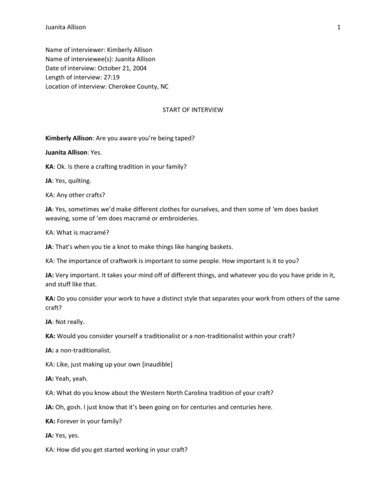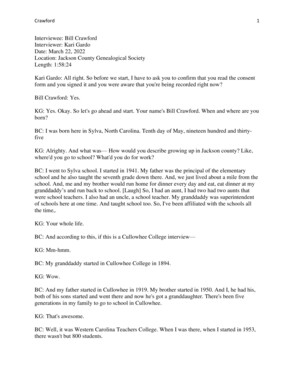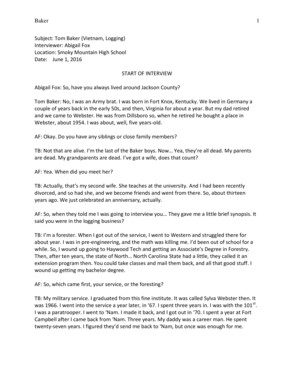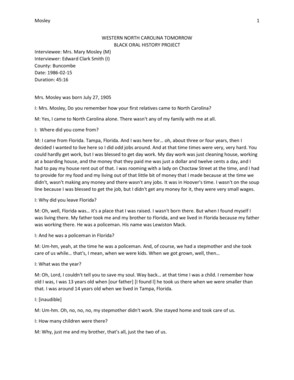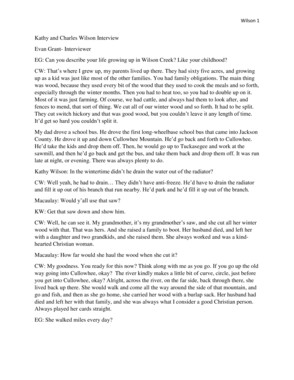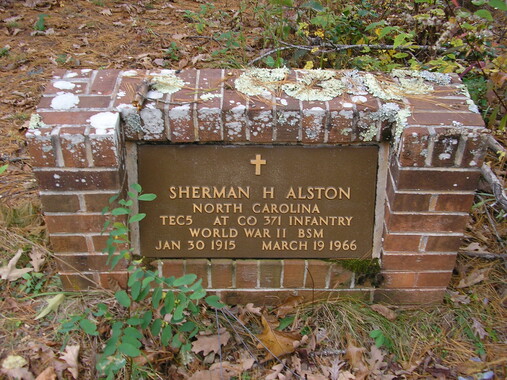Western Carolina University (20)
View all
- Canton Champion Fibre Company (2308)
- Cherokee Traditions (293)
- Civil War in Southern Appalachia (165)
- Craft Revival (1942)
- Great Smoky Mountains - A Park for America (2767)
- Highlights from Western Carolina University (430)
- Horace Kephart (941)
- Journeys Through Jackson (154)
- LGBTQIA+ Archive of Jackson County (26)
- Oral Histories of Western North Carolina (314)
- Picturing Appalachia (6772)
- Stories of Mountain Folk (413)
- Travel Western North Carolina (160)
- Western Carolina University Fine Art Museum Vitreograph Collection (129)
- Western Carolina University Herbarium (92)
- Western Carolina University: Making Memories (708)
- Western Carolina University Publications (2283)
- Western Carolina University Restricted Electronic Theses and Dissertations (146)
- Western North Carolina Regional Maps (71)
- World War II in Southern Appalachia (131)
University of North Carolina Asheville (6)
View all
- 1700s (1)
- 1860s (1)
- 1890s (1)
- 1900s (2)
- 1920s (2)
- 1930s (5)
- 1940s (12)
- 1950s (19)
- 1960s (35)
- 1970s (31)
- 1980s (16)
- 1990s (10)
- 2000s (20)
- 2010s (24)
- 2020s (4)
- 1600s (0)
- 1800s (0)
- 1810s (0)
- 1820s (0)
- 1830s (0)
- 1840s (0)
- 1850s (0)
- 1870s (0)
- 1880s (0)
- 1910s (0)
- Appalachian Region, Southern (15)
- Asheville (N.C.) (11)
- Avery County (N.C.) (1)
- Buncombe County (N.C.) (55)
- Cherokee County (N.C.) (17)
- Clay County (N.C.) (2)
- Graham County (N.C.) (15)
- Great Smoky Mountains National Park (N.C. and Tenn.) (1)
- Haywood County (N.C.) (40)
- Henderson County (N.C.) (5)
- Jackson County (N.C.) (131)
- Knox County (Tenn.) (1)
- Macon County (N.C.) (17)
- Madison County (N.C.) (4)
- McDowell County (N.C.) (1)
- Mitchell County (N.C.) (5)
- Polk County (N.C.) (3)
- Qualla Boundary (6)
- Rutherford County (N.C.) (1)
- Swain County (N.C.) (30)
- Watauga County (N.C.) (2)
- Waynesville (N.C.) (1)
- Yancey County (N.C.) (3)
- Blount County (Tenn.) (0)
- Knoxville (Tenn.) (0)
- Lake Santeetlah (N.C.) (0)
- Transylvania County (N.C.) (0)
- Interviews (314)
- Manuscripts (documents) (3)
- Personal Narratives (8)
- Photographs (4)
- Sound Recordings (308)
- Transcripts (216)
- Aerial Photographs (0)
- Aerial Views (0)
- Albums (books) (0)
- Articles (0)
- Artifacts (object Genre) (0)
- Bibliographies (0)
- Biography (general Genre) (0)
- Cards (information Artifacts) (0)
- Clippings (information Artifacts) (0)
- Crafts (art Genres) (0)
- Depictions (visual Works) (0)
- Design Drawings (0)
- Drawings (visual Works) (0)
- Envelopes (0)
- Facsimiles (reproductions) (0)
- Fiction (general Genre) (0)
- Financial Records (0)
- Fliers (printed Matter) (0)
- Glass Plate Negatives (0)
- Guidebooks (0)
- Internegatives (0)
- Land Surveys (0)
- Letters (correspondence) (0)
- Maps (documents) (0)
- Memorandums (0)
- Minutes (administrative Records) (0)
- Negatives (photographs) (0)
- Newsletters (0)
- Newspapers (0)
- Occupation Currency (0)
- Paintings (visual Works) (0)
- Pen And Ink Drawings (0)
- Periodicals (0)
- Plans (maps) (0)
- Poetry (0)
- Portraits (0)
- Postcards (0)
- Programs (documents) (0)
- Publications (documents) (0)
- Questionnaires (0)
- Scrapbooks (0)
- Sheet Music (0)
- Slides (photographs) (0)
- Songs (musical Compositions) (0)
- Specimens (0)
- Speeches (documents) (0)
- Text Messages (0)
- Tintypes (photographs) (0)
- Video Recordings (physical Artifacts) (0)
- Vitreographs (0)
- WCU Mountain Heritage Center Oral Histories (25)
- WCU Oral History Collection - Mountain People, Mountain Lives (71)
- Western North Carolina Tomorrow Black Oral History Project (69)
- A.L. Ensley Collection (0)
- Appalachian Industrial School Records (0)
- Appalachian National Park Association Records (0)
- Axley-Meroney Collection (0)
- Bayard Wootten Photograph Collection (0)
- Bethel Rural Community Organization Collection (0)
- Blumer Collection (0)
- C.W. Slagle Collection (0)
- Canton Area Historical Museum (0)
- Carlos C. Campbell Collection (0)
- Cataloochee History Project (0)
- Cherokee Studies Collection (0)
- Daisy Dame Photograph Album (0)
- Daniel Boone VI Collection (0)
- Doris Ulmann Photograph Collection (0)
- Elizabeth H. Lasley Collection (0)
- Elizabeth Woolworth Szold Fleharty Collection (0)
- Frank Fry Collection (0)
- George Masa Collection (0)
- Gideon Laney Collection (0)
- Hazel Scarborough Collection (0)
- Hiram C. Wilburn Papers (0)
- Historic Photographs Collection (0)
- Horace Kephart Collection (0)
- Humbard Collection (0)
- Hunter and Weaver Families Collection (0)
- I. D. Blumenthal Collection (0)
- Isadora Williams Collection (0)
- Jesse Bryson Stalcup Collection (0)
- Jim Thompson Collection (0)
- John B. Battle Collection (0)
- John C. Campbell Folk School Records (0)
- John Parris Collection (0)
- Judaculla Rock project (0)
- Kelly Bennett Collection (0)
- Love Family Papers (0)
- Major Wiley Parris Civil War Letters (0)
- Map Collection (0)
- McFee-Misemer Civil War Letters (0)
- Mountain Heritage Center Collection (0)
- Norburn - Robertson - Thomson Families Collection (0)
- Pauline Hood Collection (0)
- Pre-Guild Collection (0)
- Qualla Arts and Crafts Mutual Collection (0)
- R.A. Romanes Collection (0)
- Rosser H. Taylor Collection (0)
- Samuel Robert Owens Collection (0)
- Sara Madison Collection (0)
- Sherrill Studio Photo Collection (0)
- Smoky Mountains Hiking Club Collection (0)
- Stories of Mountain Folk - Radio Programs (0)
- The Reporter, Western Carolina University (0)
- Venoy and Elizabeth Reed Collection (0)
- WCU Gender and Sexuality Oral History Project (0)
- WCU Students Newspapers Collection (0)
- William Williams Stringfield Collection (0)
- Zebulon Weaver Collection (0)
- African Americans (97)
- Artisans (5)
- Cherokee pottery (1)
- Cherokee women (1)
- College student newspapers and periodicals (4)
- Education (3)
- Floods (13)
- Folk music (3)
- Great Smoky Mountains National Park (N.C. and Tenn.) (1)
- Hunting (1)
- Mines and mineral resources (2)
- Rural electrification -- North Carolina, Western (2)
- School integration -- Southern States (2)
- Segregation -- North Carolina, Western (5)
- Slavery (5)
- Sports (2)
- Storytelling (3)
- World War, 1939-1945 (3)
- Appalachian Trail (0)
- Cherokee art (0)
- Cherokee artists -- North Carolina (0)
- Cherokee language (0)
- Church buildings (0)
- Civilian Conservation Corps (U.S.) (0)
- Dams (0)
- Dance (0)
- Forced removal, 1813-1903 (0)
- Forest conservation (0)
- Forests and forestry (0)
- Gender nonconformity (0)
- Landscape photography (0)
- Logging (0)
- Maps (0)
- North Carolina -- Maps (0)
- Paper industry (0)
- Postcards (0)
- Pottery (0)
- Railroad trains (0)
- Waterfalls -- Great Smoky Mountains (N.C. and Tenn.) (0)
- Weaving -- Appalachian Region, Southern (0)
- Wood-carving -- Appalachian Region, Southern (0)
- Sound (308)
- StillImage (4)
- Text (219)
- MovingImage (0)
Interview with Juanita Allison
Item
Item’s are ‘child’ level descriptions to ‘parent’ objects, (e.g. one page of a whole book).
-
-
Juanita Allison 1 Name of interviewer: Kimberly Allison Name of interviewee(s): Juanita Allison Date of interview: October 21, 2004 Length of interview: 27:19 Location of interview: Cherokee County, NC START OF INTERVIEW Kimberly Allison: Are you aware you’re being taped? Juanita Allison: Yes. KA: Ok. Is there a crafting tradition in your family? JA: Yes, quilting. KA: Any other crafts? JA: Yes, sometimes we’d make different clothes for ourselves, and then some of ‘em does basket weaving, some of ‘em does macramé or embroideries. KA: What is macramé? JA: That’s when you tie a knot to make things like hanging baskets. KA: The importance of craftwork is important to some people. How important is it to you? JA: Very important. It takes your mind off of different things, and whatever you do you have pride in it, and stuff like that. KA: Do you consider your work to have a distinct style that separates your work from others of the same craft? JA: Not really. KA: Would you consider yourself a traditionalist or a non-traditionalist within your craft? JA: a non-traditionalist. KA: Like, just making up your own [inaudible] JA: Yeah, yeah. KA: What do you know about the Western North Carolina tradition of your craft? JA: Oh, gosh. I just know that it’s been going on for centuries and centuries here. KA: Forever in your family? JA: Yes, yes. KA: How did you get started working in your craft? Juanita Allison 2 JA: Watching my mother do it. When I was a little girl I’d set some pieces together too. KA: So she taught you? JA: Yes, yeah. KA: How old do you think you were when you started? JA: Oh gosh. Maybe, five or six. KA: And you’ve been doing it ever since? JA: Yeah. Now my granddaughter's five, and she’s started to quilt. So she’s sewing on one. KA: Did you start off quilting or did you start with something else that led into quilting? JA: Uh, I don’t really know. Maybe just sewing pieces together, mostly just making little quilts for my dolls. KA: How do your family and community affect your craft? JA: It don’t really. KA: Do you value others within the same craft? Do you admire anyone within the same craft? JA: Oh yes, yes. I have seen many quilts, like up in the Amish country? They have some beautiful work in the quilts. And then over in [Dollywood?] I’ve seen some over and there, and then at the [folk?] school, they have some quilts and judging and there’s, they just, different places they have beautiful quilts. KA: Does it take more than one person to complete a project. JA: No. But now in my case it does, because now I just make the blocks. My mama usually has to quilt them. I could quilt them, but it would take a long time [laughs] KA: So you just do like the block patterns? JA: No, not just always the block patterns. I’ve appliqued quilts, I can do the applique, and that’s when you cut out the pieces and applique it onto a block. Then the patchwork you cut pieces out and sew them together, and that makes the quilt. Then you can...embroidery, I’ve embroideried a quilt. By, in blocks, you know, you embroideries a design on it and put that together and that make a quilt. KA: So after you do all that do you sew the top part completely together, before you— JA: Yes. KA: And who puts the rest of it together? JA: My mother. She usually does the quilt, and puts the batting in it and the back on it, and quilts it. And she quilts it in different ways, whatever the pattern is, if you want it quilted by the pattern, or you can get it quilted in certain designs like a fan design or maybe quilted in squares. Just whatever you want, you know, quilted. KA: You don’t usually follow a pattern, though, do you? Juanita Allison 3 JA: No, not usually. KA: What techniques do you use that are special for you? JA: Hm, ok…well, sometimes I cut out different patterns of maybe just a squares or maybe doing diamonds, or maybe doing rectangles, whatever kind of quilt you choose, the pattern you want to choose, and sometimes—now I have a roto cutter thing that you can lay down several layers of material and cut them out, you know, and sometimes now you cut out just strips, like a certain wide, and you can sew them strips together. Now you have to sew them on a sewing machine. You can sew them together, and then cut them again in different angles, and sew them in different ways and get different designs that way, too. KA: Is the rotor cutter a time saver? JA: Oh, yes, yes! KA: Definitely. JA: Yes, because if you try cutting it out with the scissors you can only get like one or two pieces at a time, usually. KA: Probably keep it straight, too? JA: Yeah, the roto cutter, yeah, you can—it cuts perfect. KA: So that’s one tool. What other tools and supplies are needed, for your part of the quilting project? JA: Oh, tape measure, a ruler, mostly. That comes with your cutting board. You have to get a ruler that has so many different measures on it, and all that stuff. And you use that with that too, and measures and…yeah. KA: Do you follow any specific procedures? JA: No. No, not necessarily. KA: Do you start anywhere? JA: Yeah. Yeah just—yeah. KA: Where do you get your supplies from? JA: Mostly from cloth stores, fabric shops, and places like that. And then sometimes I use pieces if I’m just doing a patchwork looking quilt, I use pieces that I’ve used on different little dresses or something I’ve made, pieces like that. KA: When you go to a cloth store, do you buy in bulk or do you just buy for your specific need for that period of time? JA: Just mostly for my specific need for that time, cuz usually it takes several yard of material to make the quilt and you know you’ve to choose like what color you want it, you know, and maybe if you want to put like three colors in it, ok, or you can put the two colors. My first quilt I ever made was orange and Juanita Allison 4 green. Bright orange and green! [laughs] I think I made that when I was sixteen. Now that was for a full sized bed. But now I just choose different colors of patterns and materials. KA: Other than hands on knowledge from years of work ,do you have any other education about your craft? JA: Well, I have took a quilting class or two, that’s how I learned to use my rotary cutter, and make a quilt or two in there to, you know, get different ideals of other things. I’d like to have more time to go do more quilting classes. KA: Where do you take your classes at? JA: A fabric shop in town. KA: How did you find out about that? JA: Well, that’s where I was buying a lot of my fabric at the time, and she was telling me about they was going to have a quilting class, and so we had to bring our stuff, you know, and I had to buy my thing—my rotary cutter—and all that, so that’s when we started, I started doing a quilt class. KA: Did you learn a lot more? JA: Oh yes, yes! KA: How far have your travels taken you with quilting? Have you studied it anywhere else, other than around here? JA: No, no. I’ve went at different places in the area, I mean in different places, like I said I went up into the Amish country, and I stopped at quilting shops there and looked at their quilts, you know, just to be looking to see what they do, and you know. KA: Some people want to be mainstream, like very popular with their craft. Do you consider yourself to be one of those people? JA: No, no. KA: What do you want out of your work? JA: Hm, just the pleasure of doing it. It’s just… KA: So you don’t profit off of your craft? JA: Oh no, no, I wouldn’t dare part with a quilt, not for money! I part with them for my granddaughter, or my children, and that’s about the only people I part with one for [laughs] KA: Is it that too much work has gone into it, or that it’s too sentimental, or not? JA: Both. It’s very sentimental ,and it’s too much work goes into it to sell one. KA: Makes sense. JA: I was offered 1000 dollars for my cathedral window quilt. KA: Turned it down? Juanita Allison 5 JA: Oh yes. Spent nine solid months on that one, I would even take it to the ball games when I went to ball practice with my boys, I would sit and do it then. Everywhere I went I took pieces of that quilt to work on it. All the time, worked on it solid nine months. [laughter] KA: Lot of work on that one. JA: Yeah. KA: How many items do you think you make a year? JA: Oh, gosh…I used to really sew a lot for my nieces, and I would make them, oh gosh—a lot of dresses at a time, and now my quilting comes and goes, you know. My last quilt was made for my granddaughter, when she was borned, I worked on it for two years, off and on. Oh, let’s see—not that much anymore. I been working more in my business. KA: You make more clothing items vs quilts? JA: Yeah, yeah, really yes. KA: What presents some of the most difficult problems? JA: Oh gosh, I don’t know. Probably me thinking about getting in a hurry. And I’m having to take out more than I’m putting in [laughter] KA: How has modern advancements changed your craft? JA: Oh, it’s really helped a lot. Yes. But now my mother, she sticks to the old-fashioned way, all the way. KA: How does that compare with what you do? JA: Oh, most of the time I use sewing machine to do a lot of work, but now she does everything by hand. KA: Did you start off with a sewing machine or with everything by hand? JA: Everything by hand, yes, yes. KA:How long do you think it took you to start using the machine versus using the hand? JA: Oh, several years, probably. When growing up I wasn’t allowed to touch the sewing machine. That was no-no. So we pretty much done everything by hand KA: Do you think that made it more special for you? JA: Oh, yeah, yeah. That really taught me a lot, you know. Taught me how to sew with my hands, and to manage, yes. KA: How are you influencing new generations in your craft? JA: Oh, gosh, I don’t know! I’ve just got the little granddaughter that loves to sew, and then I had two little great nieces and a nephew that love to embroidery, and that was a good project on a snowy day when I was keeping them while their mother worked. Even the little boy, he loved, loved embroidery. I’ve drawed him out like a ship, and he embroidered on it, and then the two girls, one of them had a bird and the other one had a little house, and I spent more time untangling thread that day [laughs] Juanita Allison 6 KA: So they just wanted to learn it, or...? JA: Oh yes, yes! KA: How did your granddaughter get started? JA: Just watching me, and sitting on my lap while I’m using the sewing machine. It’s always, “nana, let me do it!” [laughs] so nana lets her do it. KA: Does she sew any by hand, or does she simply use the machine? JA: She beginning to start with her hands a little, but most of its been all by machine, but she started out with a paper towel in her hands, poking the needle in and out, so. KA: Do you have a work room or a store that you do your work in? JA: Well, yeah, kind of. I like using the dining room. I think I took it over with my crafting! KA: And do you advertise your craft in any way? Do friends or family? JA: No, no. We just always have show and tell. Even at the beauty shop, and I show and tell my sisters, and they always showing me what they done. So we call it show and tell. KA: Do all of your sisters quilt or sew in some shape or form? JA: Two of them does, the other one has no interest sewing at all. Or anything like that. KA: Are many of your friends involved in sewing and quilting. JA: Oh, yes. A lot of them sews and quilts, and a lot of them embroideries and crochets, and a lot of them knit. I’ve got one that knits, she knits a lot for her little granddaughter. KA: Have they ever had to enlist your help for anything? JA: Yes, they have called me about things. In fact I had a man to call me last night about he’s just learning to sew, and he called me last night about how to put elastic in a skirt. KA: Sometimes when I start a project, I’m excited at first but then I kind of get bored with it. What seems to keep you motivated, and keeps you focused on the project? JA: Oh, gosh! I have got bored with some things, but I think I’m bound to want to start something else but I won’t start till I get that other project finished, because I will have ten projects going at one time and none of them ever gets finished. KA: Does that happen a lot? JA: Sometimes, but not hardly any more because I usually try to just stick to the one thing. And get it done. KA: How long do you think it takes you to finish the top part of the quilt, for say, a full-sized bed? JA: Oh, gosh, like I said that one pattern I worked on for nine months, solid. Just [inaudible] how much time I get to work on it, you know. It may take months, and it may take me a year. So, you know just according on how long. Juanita Allison 7 KA: Do you have any specific quilt that you’ve made that’s the most special to you? JA: Yeah, I’ve got…one or two, yeah, that just really is special to me. Yeah. KA: Can you tell me why? JA: No, not really. It’s just, you know…I can’t really tell you why, it just is, you know. I think maybe it’s prettier, or something. KA: You said your mom quilted a lot while you were growing up. How often did she have a project going? JA: Ooh, about every winter she would start on quilting and quilt, sometimes she’d get two or three made every winter, sometimes. Sometimes she didn’t get as many. Now, she would make quilts out of all different kinds of things, like old wool britches, or whatever. Wore-out dresses or wore-out shirts, you know she could get pieces out of that, and even I know one time she even made one out of blue jeans. And that was a really heavy quilt! So. KA: So she must be pretty fast, doing all that by hand. JA: Oh, she is really fast! Yes, she is. KA: Do you think she still has any of these quilts she made while you were growing up? JA: I don’t really know. She may still have some of them, I guess she has some of the better ones that she made, yeah. KA: Well you said she would use a lot of different materials. What do you think’s the easiest material to work with? JA: Oh, cotton. Yeah. KA: Definitely. JA: Yes, yes. It does a lot better. Now, we have, I have made—I’ve got some quilts that I’ve made out of polyester, when polyester was in style, you know so I had pieces from a lot of my dresses and things that I’d made and there’s pieces in it that’s come from a lot of my different dresses out of polyester. KA: As far as warmth goes, do you think polyester and cotton would be about the same or is one better than the other? JA: Oh, no! Polyester would be a lot warmer, yes, it would be. In fact it’s a lot heavier quilt, you know the cotton quilt is not as heavy as the polyester. KA: Well what kind of batting do you put in the quilts? JA: Well, there's several different kinds that you can put. You can put a cotton ball, that’s what they used to use years ago. And if you use the cotton, you really have to quilt it real tight, you know. The—by tight I mean by having seams at least maybe an inch or two inches apart. They put a lot more quilting into it, sewing into it, putting it all together. But then because when you washed them, that cotton would wad up in knots if you didn’t. So now we use a, like a fiber stuff in them, and it’s not as heavy as Juanita Allison 8 what the cotton was. And slub in cotton a long time ago would have little pricky things in it you know, from the cotton patches I guess, you know they’d have the little pieces in the cotton. KA: How do you finish the quilt once you’ve quilted around the edges? JA: Oh, well after we put it put together? KA: Yes. JA: Oh, well the first thing you do is choose you a backing for your quilt, and you put that in a frame, and my mother still tacks her around on the frame, you know, so and then she puts down your batting, whatever you going to put in between the quilt. And now I have got some of my quilts that I have put a blanket in between, and that’s really warm too. And then you put your top down on that, and then you pin it around the edges, and stretch it. You have to really stretch your quilt good, in order to get it really quilted good. And then just start quilting in a corner or somewheres, you don’t start in the middle, you start on a corner usually, most of the time, and start from there. And go down, and then come back up you know, and then you roll that up when you get that done. KA: You said you’d put a blanket in one, one time...did you use anything other than a blanket? JA: Well [inaudible] I have backing on it, and the one, no, I don’t, it just has a blanket on the back and the quilt on the top of it. And it’s a very warm quilt. KA: What do you do after you take the quilt out of the quilting frame? JA: Oh, okay, you’ve got to finish the edges of the quilt. Sometimes people puts a binding around them, sometimes you can turn the quilt topping under and hem it that way, or either you can take the bottom of the quilt and turn it up over the top and use that as a binding, you know just turn it up and sew and then when you take it off, I mean when you have it and iron it, it looks like you may have whatever color you’ve put on the back will be having a little border around the top. Or like I said, now sometimes some people puts a border on them, even. So you can do them that way. KA: What way do you prefer? JA: Oh I prefer to have the, most of the time either the quilt turning under or either the bottom turned up, because I just don’t like having to sew another piece on there to border it and all that. KA: You said you use many different patterns. How or where do you get your patterns? JA: Oh, just from different places. If I see one in a book somewhere I can copy it, or either I've got several quilting books that I can pick a pattern out of, or if I see somebody else may have a quilt that I think, well I like that, but I’d like to put it in another color, you know. So that’s about how I get my patterns. KA: Do you draw your patterns free hand? JA: Sometimes I have, yes. KA: Are you pretty good at drawing? JA: Pretty good, yeah. It turns out pretty good most of the time. Juanita Allison 9 KA: So you’re a dual artist [inaudible] JA: Yes, yes. KA: What do you think of the younger crafters? JA: Ooh, I think a lot of them getting back into it, I love to see younger people and I love to try to teach them, help them with getting into it. I think it’s an art that don’t need to die. I think that most of the young ones won’t let it die, you know, especially when you’ve been raised around it. You come back to it, you know, and start on it. KA: You’re definitely doing your part in keeping it alive in your family. Thank you very much for your time! JA: You’re welcome.
Object
Object’s are ‘parent’ level descriptions to ‘children’ items, (e.g. a book with pages).
-
Juanita Allison is interviewed by Kimberly Allison on October 21, 2004. Longtime quilter Juanita Allison discusses the history of her craft, including how she got started, the methods, techniques, and tools she employs when making a quilt.
-
